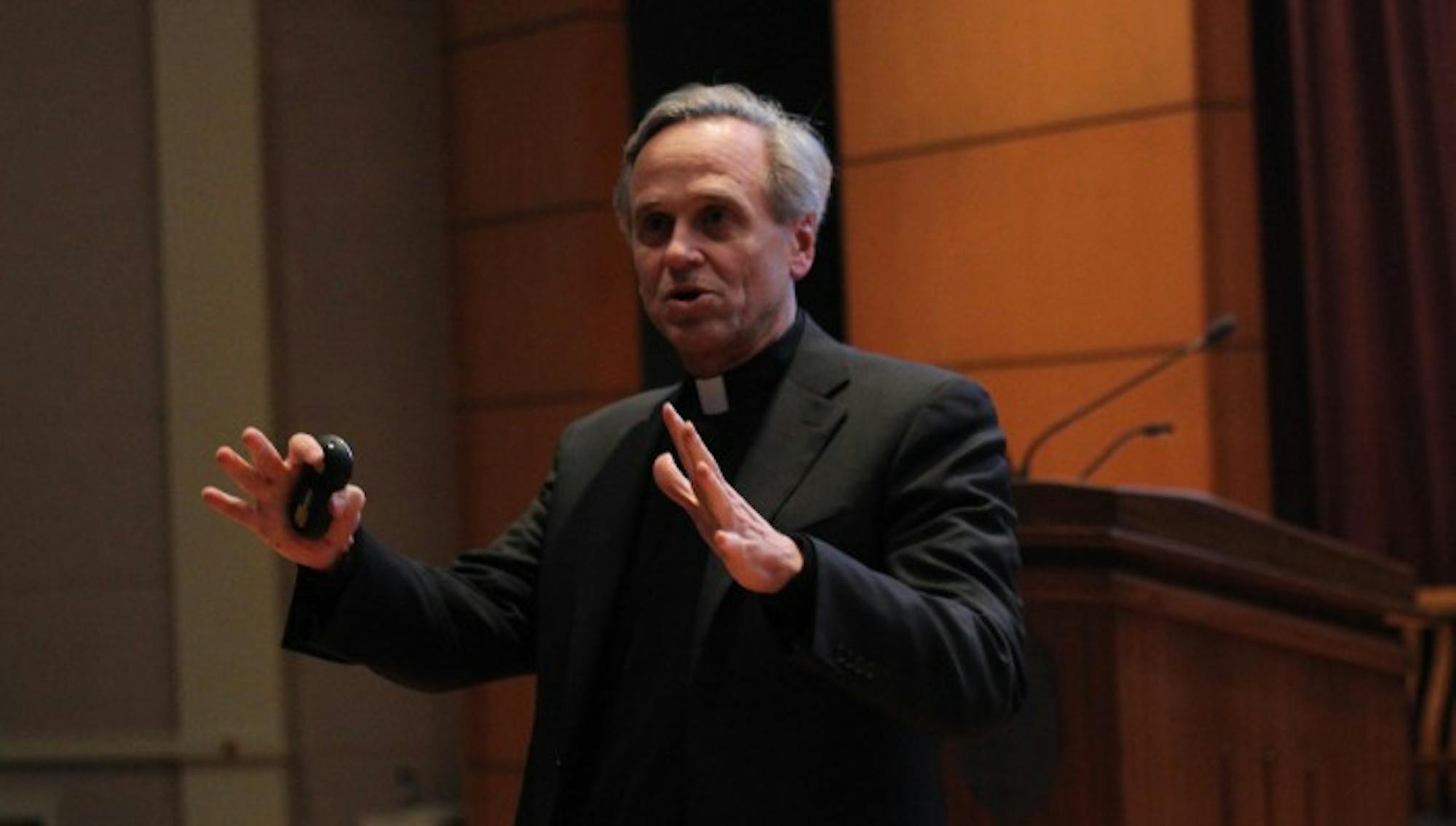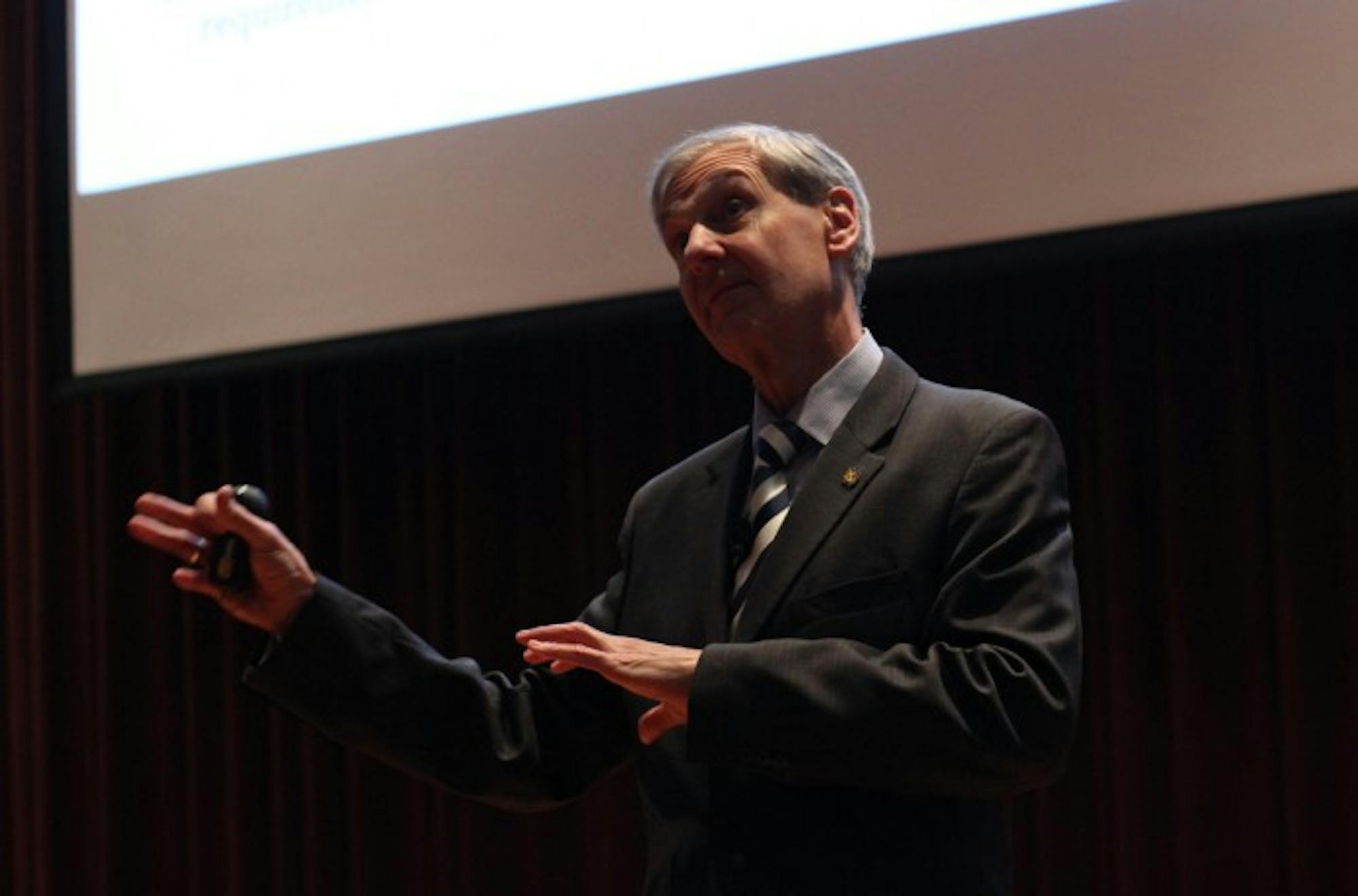University President Fr. John Jenkins announced Tuesday that the Class of 2015’s commencement ceremony will take place in Notre Dame Stadium instead of the Joyce Center, as the University originally planned.

Jenkins revealed during the town hall meeting that Commencement 2015 will take place in Notre Dame Stadium. Controversy erupted when the University previously announced plans to relocate the ceremony to the Joyce Athletic and Convocation Center.
Jenkins made the announcement at an undergraduate town hall meeting in DeBartolo Hall, during which Jenkins, University Provost Tom Burish and Executive Vice President John Affleck-Graves also updated the student body on staff diversity and inclusion, the Keough School of International Affairs, the core curriculum review and Campus Crossroads progress.
Commencement 2015
Jenkins said the Commencement ceremony’s location change comes due to a relatively mild winter, which led to better-than-expected progress on the Campus Crossroads project.“Campus Crossroads won’t be finished; there will be a little inconvenience, but I’m sure it will be minimal, and it will be a great Commencement,” Jenkins said.
Jenkins said he “can’t speak definitively” on the location of the 2016 Commencement, but did not rule out the possibility of having the event in Notre Dame Stadium.
“I think it looks good,” he said.
Keough School for Global Affairs
While the focus of the new Keough School for Global Affairs will be its Masters program, Burish said the School will offer an undergraduate program in international affairs.“It’ll be initially be a supplementary or a secondary major, and there may be a five-year Bachelor’s/Master’s program,” he said.
Burish said the School, Notre Dame’s first new college since 1921, will be housed in Jenkins Hall, a building which will replace the parking lot on Notre Dame Avenue in between the Hesburgh Center for International Studies and the DeBartolo Performing Arts Center.
Burish said the Keough School is part of a larger effort to become a “global University,” which includes sending more Notre Dame students abroad and setting aside space in the two new dorms for international students.
“No university can be a great university unless it’s a global university,” Burish said. “If you focus on a specific region, even if that region is the United States of America, your education will be outdated, and it will be delimited. It won’t acknowledge the interaction and interconnectedness of all the countries in this world.”

Core curriculum review
Burish also addressed the upcoming review of University course requirements. He said over this semester, the Core Curriculum Review Committee will consider five questions, including the curriculum’s relation to Notre Dame’s Catholic character and the role of Advanced Placement credits.The committee will make a recommendation for a new core curriculum and lead a campus-wide discussion for a year before a final decision is made. Burish invited the student body to attend forums and focus groups and to send feedback to the committee by email.
“Examining the core curriculum and how it could help you in your future and expanding the way we become a global University are two of the most important [academic concerns], and I hope all of you will participate in both of those,” he said.
When asked if the two theology course requirements were in danger, Burish said while all University course requirements stand to be reworked, there is no push to reduce or eliminate the theology requirement.
“We’ve asked everyone to address any one of the questions,” Burish said. “We haven’t said, we won’t listen to you if you ask about theology classes. Someone might say, there should be three. Someone might say, there should be one. Someone might say there’s a different way to substantiate Catholic character which includes theology, but we should add other kinds of courses. We’re not going to say, we won’t listen to you; we’ve already made up our minds.”
Campus Crossroads
Graves primarily addressed Campus Crossroads, the $400 million stadium addition which began construction in November. He said the project will add academic and student space to an area close to where students live and go to class.“At many many other schools that have built up around their stadium, the decision was to move the stadium. We weren’t going to do that. At least, I wasn’t going to do that and live,” Graves said. “So the question was, can we use the stadium in some way? And that was really the genesis of the idea. So the idea was to include some academic spaces in the complex in the heart of campus, and then put a student center there which would serve all the students.”
The additions, built on three sides of the stadium, will house the music, sacred music, anthropology and psychology departments, as well as a digital media center, a student union with restaurants and a common space, a gym to replace the Rolfs Sports Recreation Center, space for clubs and student media, the Career Center, a ballroom and premium seating for the stadium.
“Instead of having a beautiful football stadium, very traditional, in the middle of campus, used eight or nine times a year — six football games, the Blue-Gold game, commencement, which is what it gets used for — we’ll take it and make it a space that is used 300 days a year,” Graves said.
When asked how the University will keep the project on budget, Graves said $200 million of the project’s budget comes from donations and money already set aside for specific purposes, such as moving the psychology and anthropology departments. The other $200 million will come from the sale of season tickets for the premium seating.
Graves said Rolfs will become a practice facility for the basketball teams and the Rockne Memorial Gymnasium will remain a gym. The future use of other buildings such as Haggar Hall, which currently houses much of the psychology department, is unclear.
By August, the steel structures on two sides of the stadium will be constructed, and the project will be complete in July 2017, Graves said.
Diversity and Inclusion
Jenkins recapped three of the motivations in the University’s efforts to increase diversity and inclusion, which he said has been of special importance to the administration for the past year.“First, it’s a richer educational environment if it’s a more diverse environment,” he said. “Second is, we can attract a wide variety of students, faculty, staff. The third is that the people who are here, if we’re more diverse and inclusive, are happier with their experience.”
Jenkins said the University’s student diversity initiatives included spreading awareness of Notre Dame’s spirit of inclusion; the creation of Speak Up, a website with information about and a reporting mechanism for sexual assault and harassment; Martin Luther King, Jr. Day celebrations; increasing hall staff diversity and awareness of socioeconomic diversity and the first-year course that will replace the physical education requirement.
Jenkins said faculty diversity initiatives have included surveys, ongoing inclusion training and special efforts to recruit and retain faculty of color. New staff now have multicultural competency training; the University recently hired Eric Love as director of staff diversity and inclusion and Christina Brooks as diversity recruiting program manager, and it created a strategic plan to address staff diversity issues.
When asked to elaborate on staff diversity initiatives, Graves said he directed his office to create a two- to three-year action plan for increasing staff diversity and inclusion, which would address specific areas such gender and ethnic diversity across different categories of staff, though he did not give any concrete plans.
“I purposefully try to avoid putting in a quota,” he said. “What I’m trying to do across my division, which is mostly the business side of the University, is to say, what are the areas where we need to improve, and to challenge my nine direct reports to tackle the situation. I’m not going to go to one person and say, you have to hire someone. What I’m saying is that across the nine of us, two years from now, we should look differently from how we do now. We jointly have to take that responsibility.”
Divestment
In response to a student’s question asking whether the University would divest from fossil fuel companies, Jenkins said the plan is to move towards a more gradual reduction of fossil fuel usage.“We’re sitting in a room that’s heated and lighted, and when we drive to where we go, we use fossil fuels,” he said. “It seems to me that it would seem to be hypocritical to say, ‘we’re going to divest from the companies we rely on for the energy, what we need to do business.’ So I think what we need is a gradual but more determined effort to make our use of energy sustainable.”













